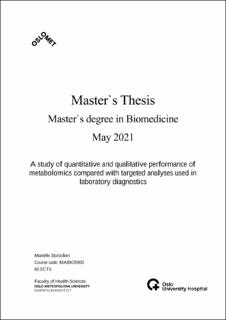A study of quantitative and qualitative performance of metabolomics compared with targeted analyses used in laboratory diagnostics
Master thesis
Published version
Permanent lenke
https://hdl.handle.net/11250/3123474Utgivelsesdato
2021-05Metadata
Vis full innførselSamlinger
Sammendrag
Today, several specific and targeted analyses are used for detection of different chemical compounds and diagnostics of inborn errors of metabolism (IEMs). Metabolomics, an untargeted analytical approach, has been used as a supplement to established targeted analytical approaches in diagnostic laboratories for more effective diagnostics of IEMs. However, little is known regarding the quantitative performance of metabolomics, and a higher level of confidence is needed for metabolite identification. A metabolomics method that is well suited for easily accessible biological materials e.g. urine and plasma is an advantage. The aim of this study was to evaluate the quantitative and qualitative performance of the established metabolomics method HPLC – ESI – Q Exactive Orbitrap MS studying amino acids and amino acid related compounds, diagnostic markers, in urine and plasma samples. Almost all the selected compounds were identified with level 1 identification, the highest level of confidence, using the in-house library that was created in this thesis. The in-house library will be used for identification of amino acids and related compounds in future metabolomics studies. The metabolomics method is a useful diagnostic tool, as the diagnostic metabolite PEA, which is not quantified by established targeted methods in the diagnostic laboratory of IEMs at Oslo University Hospital – Rikshospitalet, was successfully detected. The precision of the metabolomics method was good for most of the selected compounds in urine and in plasma (retention time <2%, and peak area <30% RSD). Urinary metabolites were normalized to creatinine concentration, and the correlation between amino acid peak area from metabolomics and measured concentration ratios from targeted analyses was found. The correlation was better in samples diluted to 0.1 mM creatinine than to higher creatinine concentrations, and approximately linear. This correlation was also found comparing diagnostic markers for cystinuria in normal urine samples to a pathologic sample, and in samples spiked with different concentrations of PEA representing normal samples and HPP. However the qualitative performance of the metabolomics method was better when urine samples were diluted to 2 mM creatinine. Furthermore, several of the selected compounds were affected by chromatographic matrix effects, ion suppression or ion enhancement in plasma. Less variation was found in plasma samples than in urine samples. This study showed that metabolomics is a useful tool for diagnostics of IEMs, e.g. HPP and cystinuria, but it is important to remember that at higher matrix concentrations, matrix effects can cause false positive and negative results. I dag brukes flere spesifikke målrettede analysemetoder for deteksjon av ulike kjemiske forbindelser og diagnostikk av medfødte metabolske sykdommer. Metabolomikk – en ikke-målrettet analytisk metode har vært et nyttig supplement for en mer effektiv diagnostisering av medfødte metabolske sykdommer. Lite er kjent for hvor kvantitativ metabolomikk kan være, og en høyere grad av sikkerhet er nødvendig for identifisering av metabolitter. En metabolomikkmetode som er godt egnet for studier av urin og plasma er en fordel da disse biologiske materialene er lett tilgjengelige. Hensikten med denne studien var å evaluere den kvantitative og kvalitative evnen til metabolomikkplattformen for studier av aminosyrer og aminosyre-liknende forbindelser, som er diagnostiske markører, i urin og plasma. Omtrent alle de utvalgte forbindelsene ble identifisert med nivå 1 identifisering, det høyeste nivået av sikkerhet, ved bruk av internbiblioteket som ble laget. Dette biblioteket vil bli brukt for identifisering av aminosyrer og aminosyre-liknende forbindelser i fremtidige metabolomikkstudier. Metabolomikkmetoden er et nyttig diagnostisk verktøy da den diagnostiske markøren fosfoetanolamin (PEA), som ikke kvantiteres med de målrettede metodene som brukes på Oslo Universitetssykehus – Rikshospitalet i dag, ble detektert. Metabolomikkmetoden viste god presisjon for de fleste av de studerte forbindelsene i urin og plasma (retensjonstid <2 %, og toppareal <30 % RSD). Metabolitter i urin ble normalisert til kreatininkonsentrasjonen og sammenhengen mellom aminosyrenes toppareal fra metabolomikk og konsentrasjonsratioene fra målrettede analysemetoder ble funnet. Sammenhengen var bedre når urinprøvene ble fortynnet til 0.1 mM enn 2 mM kreatinin. Denne sammenhengen ble også funnet for de diagnostiske markørene til cystinuri i normale urinprøver og en patologisk prøve, og for prøver som ble spiket med ulike konsentrasjoner av PEA for å representere normale og HPP-prøver. Den kvalitative evnen til metabolomikkplattformen var bedre når urinprøver ble normalisert til 2 mM kreatinin. Videre viste det seg at flere av forbindelsene ble påvirket av kromatografiske matrikseffekter, ionesuppresjon, eller ioneforhøyelse i plasma, men at det var mindre variasjon i plasmaprøver enn i urinprøver. Denne studien viste at metabolomikk er et nyttig verktøy i diagnostikk av medfødte metabolske sykdommer, som HPP og cystinuri, men at for lite fortynnede matrikser kan gi falske positive og negative resultater.
